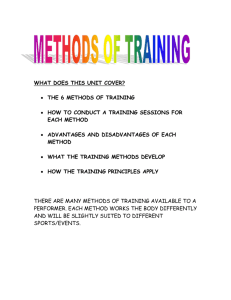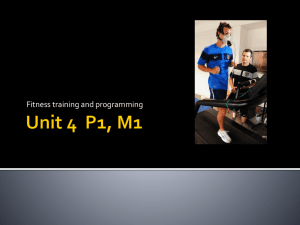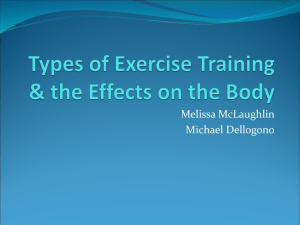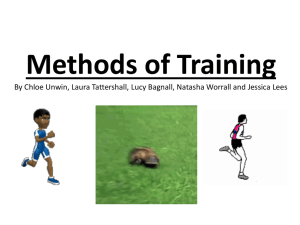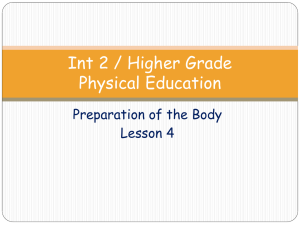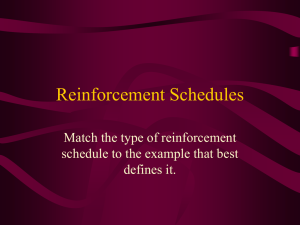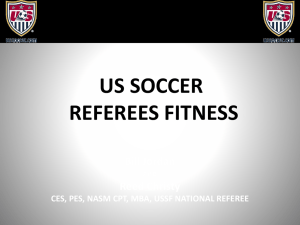Methods & Types of Training
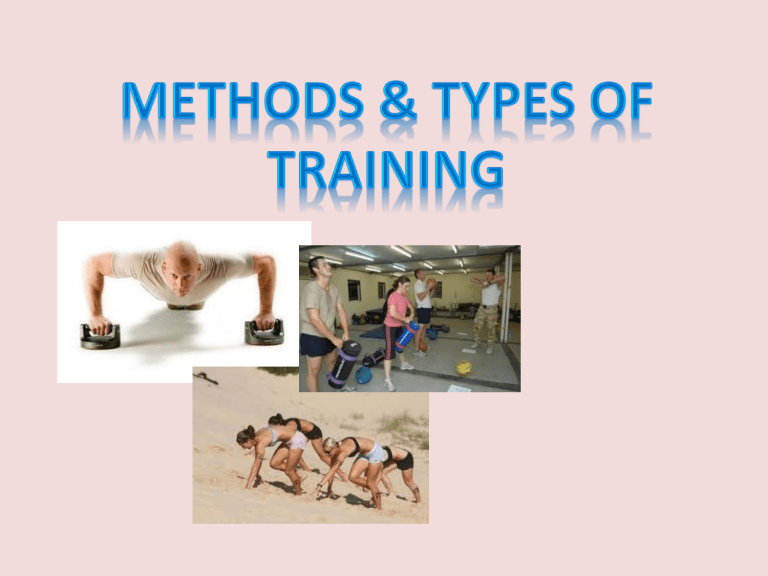
Training Methods
Interval Training
Continuous Training
Fartlek Training
Circuit Training
Plyometric Training
Flexibility Training
Resistance Training
Training Methods
Other Methods
• Speed Training
• Pilates
• Swiss Ball
• Skill Training
Interval Training
Interval training involves periods of hard work followed by a timed period of rest, repeated several times in one training session.
The periods of hard work are called high intensity activity.
Rest can be active (walking, jogging etc)
An example of interval training is 10 fast runs over 40 metres, with a two minute rest between each run.
Distance, speed and the length of recovery time can be varied to suit your level of fitness and your sport
Varied recovery time determines energy system used.
Interval training develops both your aerobic and anaerobic fitness.
Interval Training
Variables to consider during interval training;
Distance/duration of activity,
Intensity of activity, duration of rest, activity during rest, number of sets, frequency of training.
By varying any of the variables we can progressively overload the athlete
This allows the athlete to train at higher intensities than they are used to
This will steadily increase their fitness
Therefore allow athletes to run faster and increase their recovery rate during competition
This form of training also increases fitness levels for people involved in exercise
Interval Training
Intensity of interval training is higher than that of continuous training
Therefore requires a greater energy production to sustain the activity.
This means interval training burns more calories
This leads to a faster loss of body fat
Energy System Interval Training
The following recommended guidelines for training with each of the 3 energy systems are:
-Aerobic intervals: 1 or ½ a unit rest for every unit of work:
-i.e. 4minutes high intensity work; rest for 2-4minutes
-Lactic Acid Intervals: 2 to 3 units of rest for 1 unit of work
-i.e. Sprinting for 1minute, rest for 2-3minutes
-APT/PC intervals: 6 units of rest for 1 unit of work
Sample Aerobic Interval Session
First estimate Max HR this will help you work out percentage of
Max HR you will work at:
Basic interval:
Work = 4 minutes
Rest = 2 minutes
4 sets of 4 minutes at 70%
Max HR effort with 2 minutes rest
Pyramid Interval:
Work = 3 minutes
Rest = 1.5 minutes
• Treadmill hill pyramid:
• Find the speed that produces 70% of your Max HR
• Stay at that speed throughout your interval then vary the gradient on the treadmill
• Work 2 minutes
• Rest 1 minute
• Warm up: 2minutes @ 2% gradient
• Rest
• 2 minutes @ 4% gradient
• Rest
• 2 minutes @ 6% gradient
• Rest
• 2 minutes @ 4% gradient
• Rest
• 2 minutes @ 2% gradient
Sample Anaerobic Interval Session
Lactic Acid System:
-6 sets of 45 seconds
(or 300m) at 90-95% effect with 90 second’s rest
ATP/PC:
- 10 sets of 50m at
100% effort with
1minute rest
-4 sets of 75 seconds
(or 500m) at 80-85% effort with 150 seconds rest
Interval Training
Advantages:
Highly structured , specific to game, can measure progress, all energy systems can be trained, minimal equipment required.
Improves: speed, strength, aerobic endurance, fat burning potential, burning of calories and performance
Lactate tolerance exercises occur at high intensities and usually involve intermediate interval training. At these high intensities, athletes/muscles produce large concentrations of lactate and the body adapts to this by improving it's clearance and alkalai buffering capacity .
Interval Training
Continuous Training
Long, slow distance (LSD) training.
Often refereed to as steady state
No rest or break period for at least
20 minutes.
Works aerobic energy system.
Time should meet demands of game length.
Examples; Jogging, cycling, rowing, walking
Max Intensity – 80-85% max H.R
Min Intensity - 65-70% max H.R
Time – at least 20 minutes
F = Frequency (At least 3 to 4 sessions per week)
I = Intensity (In aerobic zone)
T = Time (Minimum of 20 minutes)
T = Type (Whole body activities that use large major muscle groups)
Continuous Training
Disadvantages:
The main drawback of continuous training is that it does not improve speed or agility. This means it is not ideal for games players who need to be able to change pace.
Continuous training can also be extremely boring!
Benefits;
• Less demanding than anaerobic training.
• Provides health benefits.
• Low risk of injury
• Lowered resting H.R
• Increased stroke volume
• Thicker heart muscle
• Increase muscle enzymes
• Reach steady state quicker
• Slower lactate accumulation
• Faster recovery
Training and LT/LIP
VO
2 max is just one's ability to take up, transport and utilise maximal amounts of oxygen at maximal aerobic exercise.
To increase one's VO
2 max, exercise has to be performed at intensities at or above lactate threshold (LT/LIP).
Intensities somewhat higher than LT are usually used and believed by most (70% of literature) to be the best for raising
VO
2 max, LT intensity has been shown to be just as effective at raising VO
2 max in some athletes (30% of literature).
Fartlek Training
Variation of continuous training.
It involves short bursts of intense work during a continuous activity.
Fartlek is Swedish for ‘Speed Play’.
Works both aerobic and anaerobic systems.
Session can be either structured or unstructured.
Can be done in small areas and is suitable for all fitness levels.
Intensity – sub-maximal which changes.
Overload – Increase frequency, duration, distance of intense bursts.
Covering same distance in less time.
Benefits;
Energy systems can be trained.
Adds variety to a continuous training program .
Advantages
• Fartlek training can be used to improve both the aerobic and anaerobic systems by mixing moderate activity with bursts of speed.
• It can be varied to suit the fitness level of each individual performer and the available time they have to train.
• This type of training can be used to avoid boredom in sports like running and cycling which can be monotonous.
Disadvantages
• As the performer decides on the intensity of work, it can be hard for coaches to tell if performers are working as hard as they should be.
Fartlek training – an example
An example of a Fartlek training session:
10 minute jog to warm up.
Sprint hard for 30 seconds.
Jog for 2 minutes.
Run (about 75% of max) for 50 seconds.
Jog for 2 minutes.
Repeat 6 times, reducing the periods of jogging by 10 seconds each time.
10 minute warm down jog.
Circuit Training
Uses stations (6-15) that focus on specific components of fitness.
A complete circuit should take between 5 and 20 minutes with 15-30 seconds rest between each station.
Coaches can design a circuit manipulating the following variables;
Fitness components used
Type and number of exercises
Number of reps
Number of circuits to be completed
The length of recovery
Specificity – Exercises can be made specific to the game.
Time- A lap should take 20 minutes with 15-20 break.
Overload – Number of reps, time, laps, recovery time, resistance.
Circuit Training
Benefits;
Develops a range of fitness components.
Maintains interest – can be varied.
Can be used to work on weaknesses.
Progress can be measured.
You can target specific muscle groups.
You can include weight training activities to increase strength.
You can increase the length of each activity to train the aerobic system.
You can include skill-based activities.
Disadvantages:
• Circuit training can take time to arrange and often requires a lot of equipment
Examples; Step-ups, sit-ups, press-ups, squat jumps, shuttle runs, pull ups.
Circuit Training Methods
Three main types of circuits;
1. Fixed load
- 50 seconds per exercise
- 3 circuits in 20 minutes
- Loading is increased each set
2. Fixed time
- Max reps in time given
3. Individual load
- Max reps in 1 minute.
- Athlete works at 60,70 or 75% rep max.
- Or Score is halved and attempted in 2/3 of the time taken to do three complete circuits.
Circuit Training
Here is an example of a circuit designed for footballers.
dribbling press-ups sit-ups keepyuppy
2 MINUTE
STATIONS passing sideways jumps sprints
Plyometric Training
New name for skipping, bounding and jumping – developed in Eastern
Europe and Russia.
It develops muscular power from a stretch reflex.
Trains eccentric aspect of muscular contraction. Speed is vital.
Example; Leaping, bounding, hopping, rebounding.
Note – Height should not exceed 25cm
(Low impact), 35cm high impact.
Overload – Altering sets or reps.
Benefits;
• Trains neuromuscular system.
• Develops power
• Replicates game movements
• Minimal equipment required.
Considerations;
• Athlete needs sound strength and endurance
• Use less stressful drills for beginners
• Not recommended for children under
15 years old.
• Train on shock absorbing surfaces
• Frequency – 2 (off-season) and 1 (inseason).
• Recovery time – 48 hours
Low Impact
Reps – x10 Sets- x 1-5 Recovery – 3 min
High Impact
Reps – x10-25 Sets – 1-5 Recovery- 10min
Flexibility Training
Ability of specific joints to move through the range of motion required.
Methods;
1. Passive (Static) – Holding stretch for 15-30 sec
2. Slow Active Stretching (SAS) – Stretch, relax then restretch. Used in aerobics.
3. Proprioceptive Neuromuscular Facilitation (PNF) – Usually partner assisted stretch. Full lengthening of muscle which contracts isometrically.
4. Ballistic* – Moving through range of motion using momentum.
*Not recommended unless well warmed up.
Frequency – 3-4 sessions per week
Should be included in addition to any training program.
Flexibility is required in all sports.
Weights (Resistance) Training
Improves muscular strength, power and endurance.
Terminology-
Rep – Single effort
Rep Max (RM) – max number of reps in a row
Set – Number reps in a sequence
Resistance – Amount of weight
Benefits;
Non specific groups can be targeted
Variety of exercises used
Strength, power and endurance can be targeted
Record progress on performance chart.
Resistance Types
1. Free weights (isotonic):
Traditional form
- Uses dumbbells and barbells
- Dynamic movement
- Works concentric and eccentric phases.
2. Fixed resistance (isometric):
- Holding a fixed position while the muscle contracts against resistance
- Tension increases but the muscle stays the same length.
- Increases strength in the static position – minimal use in dynamic sports.
Examples; Pushing against a wall, handstands, crucifix position on the roman rings.
3. Isokinetic:
- This is known as ‘accommodating’ resistance.
- Machines can adjust the load as the body part moves through the range of motion.
- Limited benefits to the speed in which the machine will operate.
Examples; Cybex, Kincom, Biodex and Hydragym.
Speed Training
Speed training draws on other training methods
It requires rehearsal of the neural pathways responsible for speed.
Speed is dependent on stride frequency and stride length:
1. Stride Frequency
Speed strength exercise
Plyometrics
Downhill running
Windy day running
Resistance techniques (Parachute)
2. Stride Length
Developing strength, power, endurance and technique analysis.
Pilates and Swiss Ball
Pilates:
Gentle method of developing core body strength.
Strengthens the deep postural muscles.
Classes improve breathing and posture.
Integrates physical & mental conditioning, relaxation and breathing techniques.
Relieves stress, fatigue, physical discomforts and increases selfconfidence.
Swiss Ball
Like pilates, the swiss ball develops the deep postural muscles.
The exerciser uses the ball for;
Static movements
Dynamic movements
Postural movements
Can be used in gyms, home (Eg. Fitball) or the workplace .
Motor Skill Development
Motor skills can be learnt and developed through training.
We obtain some skills genetically, however training will enhance these abilities further.
Stages of Learning
Cognitive – Beginner
Associative – Learning
Autonomous – Expert.
Skill level will depend on;
Age, gender, feedback given, recognition of faults, being able to correct faults, perceived ability, level of practice, motivation, physical maturation, fitness capacity, memory .
